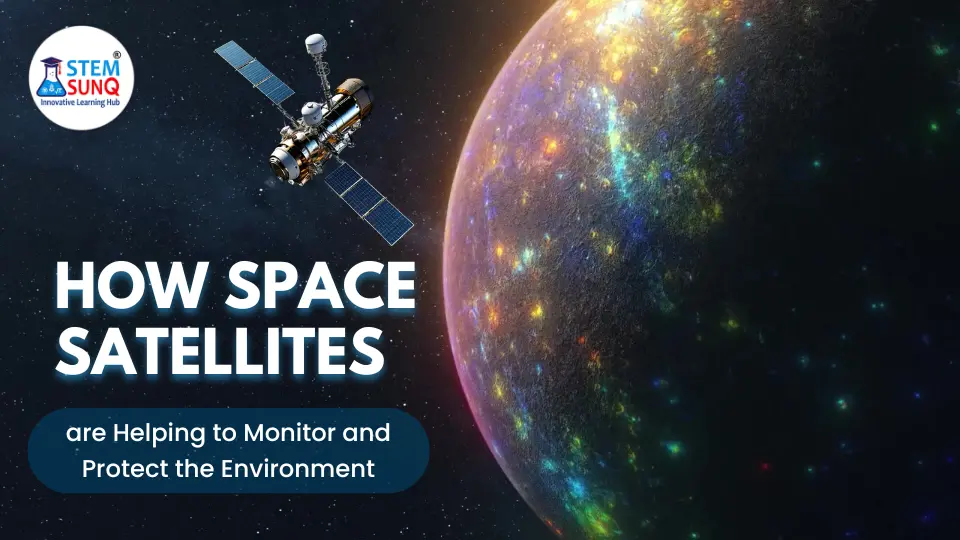
Table of Contents
When we look up at the night sky, we are easily attracted by the stars, but even more amazing is the network of space satellites circling above us, silently working to safeguard our planet.
These space satellites serve an important role in monitoring the Earth’s ecosystem, giving scientists the data they need to understand and address some of our planet’s most pressing concerns.
Also read: Student’s Guide to Space Science with 5 Amazing ISRO Educational Resources
The Power of Space Satellites in Environmental Monitoring
Satellites have transformed how we monitor and preserve the environment. They provide a unique perspective by collecting data across broad areas that would be impossible to monitor from the ground.
Satellites help scientists and politicians make educated decisions by tracking deforestation and predicting natural disasters.
One of the most important contributions of satellites is to monitor climate change. Satellites measure the Earth’s temperature, monitor greenhouse gas emissions, and track ice cover variations in the polar regions.
According to NASA, satellite data shows that Arctic sea ice is disappearing by around 13% every decade, highlighting the urgent need for climate action.
Protecting Forests and Wildlife
Forests are sometimes referred to as the Earth’s lungs because they play an important role in carbon dioxide absorption and oxygen production.
However, deforestation is a major danger to this natural balance. Satellites are useful in monitoring changes in forest cover.
They can detect illegal logging, monitor forest health, and even help with replanting operations.
For example, the Brazilian government employs satellite data to monitor the Amazon rainforest, which is the world’s largest tropical rainforest.
This information enables authorities to identify illegal deforestation and take action to protect this critical environment. As a result, satellite monitoring has become an invaluable tool in the fight against deforestation.
Satellites not only help to conserve forests but also wildlife. They monitor sensitive species’ habitats, analyze migration patterns, and identify ecosystem changes that might harm biodiversity. Satellites allow conservationists to act quickly to safeguard threatened species and habitats by delivering real-time data.
Disaster Prediction and Response
Natural disasters such as floods, hurricanes, and wildfires have severe effects on both the environment and human life.
Satellites play an important role in anticipating and responding to disasters. Satellites can help predict and provide early warnings for natural disasters by monitoring weather patterns, ocean temperatures, and land conditions.
For example, during the 2020 wildfire season in Australia, satellites were used to track the spread of flames, assess damage, and aid in the coordination of firefighting activities.
Satellite data was important in controlling the crisis response and reducing its environmental impact.
Furthermore, satellites contribute to disaster recovery by giving detailed photographs of impacted areas. This information allows authorities to estimate the degree of the damage, allocate resources, and organize reconstruction efforts.
In flood-prone areas, satellite data is used to generate flood maps, which are critical for emergency preparation and response.
Monitoring Pollution and Human Impact
Human actions have a huge impact on the environment, frequently causing pollution and environmental damage.
Satellites are used to monitor air and water quality, track oil spills, and detect pollution from industrial activity. This data is critical for implementing environmental legislation and ensuring that industries meet environmental standards.
For example, the European Space Agency’s Sentinel-5P satellite monitors air pollution levels throughout the world.
It gives real-time data on pollution levels such as nitrogen dioxide, ozone, and carbon monoxide.
This data is essential for governments and environmental organizations to take action to minimize pollution and safeguard human health.
The Future of Environmental Monitoring
As technology progresses, satellites will play an increasingly important role in environmental monitoring. New satellites are being launched with improved sensors and capabilities, providing even more complete and accurate data. Furthermore, as satellite data becomes more widely available to the public and scholars, our ability to safeguard the environment will improve.
One promising development is the use of small, low-cost satellites called CubeSats, which can be deployed in huge numbers to offer continuous worldwide surveillance.
These small satellites are likely to play an important role in future environmental protection efforts.
Conclusion
Space satellites are essential resources in the effort to safeguard the environment. It offers us the information we need to track changes, foresee calamities, and take action to protect our world.
As we continue to face environmental concerns, the function of satellites will become increasingly important.
By leveraging space technology, we can work toward a sustainable future in which the Earth’s natural beauty and resources are conserved for future generations.






